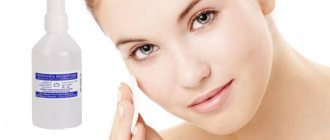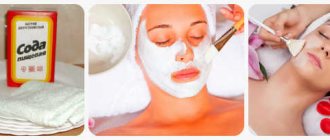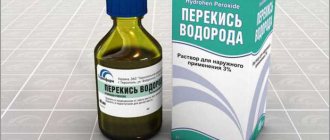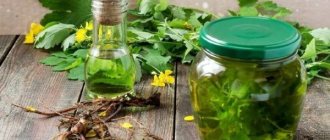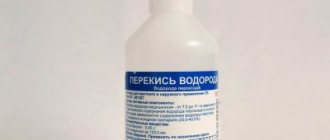In home cosmetology, hydrogen peroxide for acne on the face has been used since the appearance of the product in everyday life. The medicinal mixture can be easily made at home, because... the necessary ingredients are sold without prescriptions at any pharmacy. Masks and tonics are made based on H2O2. Peroxide masks contain different ingredients: cosmetic clay, aspirin, badyaga, yeast and even baby powder. A properly prepared product will help eliminate almost any facial skin problem.
The causes of acne and pimples on the back and face can be genetic disorders, endocrine disorders, malfunction of the sebaceous glands, and bacterial infections. When harmful bacteria enter the pores of the skin, they begin to multiply rapidly, which leads to inflammation of the epidermis. Simply rubbing hydrogen peroxide on your face is not enough. To get rid of blackheads, pustules or age spots, you need to strictly follow the rules and recommendations from this article.
General characteristics of the product
Hydrogen peroxide is known for its antiseptic properties. It is used to cleanse wounds of pus, blood residues and as an antiseptic. However, peroxide has been experimentally shown to prolong the healing period of wounds. This happens because the skin cells adjacent to the wound are damaged by the solution. This in turn can contribute to scar formation. In addition, the solution has a bactericidal effect not only against pathogenic flora. It also destroys beneficial inhabitants of the skin, which can cause a violation of local immunity.
Conclusion: peroxide is considered to be an “ambulance” in the treatment of acne, but is not an acceptable remedy for long-term use.
How does peroxide work on acne?
The main factors for the appearance of acne are an excessive increase in sebum production, the rapid rate of desquamation of epidermal scales and the proliferation of acne bacteria. As a result of their vital activity, bacteria produce enzymes that cause the appearance of inflammatory elements. Peroxide, when applied to the skin and when interacting with oxygen, quickly decomposes into singlet oxygen and water. It is active oxygen that has a toxic effect on bacteria and their number is sharply reduced.
Hydrogen peroxide against acne works in several ways:
- removes pus by forming a hissing foam on the surface of the pimple;
- kills microorganisms, including acne bacteria, which are provocateurs of pustular neoplasms on the skin;
- Lightens pigmentation and stagnant acne spots.
It is ineffective and unsafe to use peroxide for acne on the face, which is located under the skin and for closed comedones. The solution works best with purulent acne when the necrotic contents come out. In this case, peroxide cleanses the ulcer well from the remaining purulent mass.
Important! Peroxide against acne only helps if the causes of their appearance are related to external factors. Acne caused by hormonal disorders, internal diseases, or those of a genetic nature can be treated with peroxide to no avail, since it does not affect the cause of its appearance.
What is hydrogen peroxide
A peroxide molecule has two oxygen atoms. Once on damaged skin, the substance disintegrates. The oxidation process begins. As a result of this action, a large amount of foam is formed, which helps to soften the damaged tissue and separate dead cells, blood clots and pus. Oxygen attracts contaminants and brings them to the surface, wounds are disinfected.
Ways to use hydrogen peroxide against acne
The first thing you need to know is that wiping your face with hydrogen peroxide for acne is strictly prohibited if it is in undiluted form. Even in a small concentration (1-3%) the product can cause a burn to the skin, which manifests itself as white spots that do not go away for a long time. With a severe burn, tissue death may begin, which, even with timely treatment, will resemble an unsightly scar or pigmented mark. Therefore, you can treat a pustule from which purulent masses have drained with undiluted peroxide. In this case, it will cope with the following tasks:
- completely cleanse the resulting wound from pus;
- will prevent the penetration of pathogenic flora;
- will stop bleeding if they tried to put pressure on the abscess and damaged small vessels.
Therefore, to the question of whether it is possible to burn pimples with hydrogen peroxide, the answer is yes, but this must be done very carefully, trying to ensure that the product does not get on healthy areas. In order to cauterize the abscess, you should use a cotton swab. Moisten it generously in the solution and quickly apply to the eel. You may need to apply the stick to one place several times. It is important to remember that prolonged exposure can cause burns and tissue damage.
If acne covers large areas of facial skin, then you can wipe them only with diluted peroxide. To do this, take 1 part of peroxide and 10 parts of water at room temperature, pre-boiled. This method can be used for no more than 2 days in a row, lubricating areas with acne on the face twice a day.
Advantages and disadvantages
Rubbing the face with hydrogen peroxide, according to women, can provide the following results:
- facial hair lightens and becomes less noticeable;
- freckles and pigmentation become discolored;
- the inflammatory process decreases;
- blackheads and traces of them are removed;
- cells are saturated with oxygen;
- pathogenic microflora is eliminated;
- the skin is cleansed of dead cells;
- blood circulation improves.
Despite many positive properties, hydrogen peroxide is capable of:
- cause allergic reactions;
- cause burns on the skin;
- should be used with caution on sensitive and dry skin.
Hydrogen peroxide should not be used if there are various inflammatory processes in the body.
Recipes using peroxide
Hydrogen peroxide for acne is used as a component of masks and tonics. Combination with other components reduces its aggressive properties for the skin, while maintaining the main actions.
It is enough to add a few drops to the lotion and wipe your face 2 times a week. The concentration calculation is as follows: 10 drops of peroxide per 100 ml of lotion.
Important! Any prepared product based on peroxide and other components should be tested for the presence of an allergic reaction before applying to the face.
To carry out the test, a small amount of the finished drug should be spread on the skin of the wrist, the inside of the elbow or behind the ear and left for 10 minutes. In the absence of irritation, redness and itching, it can be used as directed.
Multi-layer mask with yeast
You can apply the product prepared according to the following recipe directly to pimples:
- Grind brewer's yeast (sold in pharmacies as a dietary supplement) into powder.
- Add peroxide until the consistency becomes creamy (so that it sticks well when applied).
- Apply the mixture to each pimple. After drying, apply a second layer and then a third.
- After the last layer has dried, rinse with warm water.
Peroxide will clear the contents of rashes, and brewer's yeast will serve as a source of thiamine and biotin. In addition, yeast contains zinc, selenium and sulfur, which are necessary for normal metabolic processes in the dermis. This mask has an antiseptic and anti-inflammatory effect.
Aloe mask
Aloe or agave is the most effective plant in the fight against acne. Combination with hydrogen peroxide enhances the antiseptic effect of the latter.
The use of such a combined acne remedy performs several tasks:
destroys bacteria that, under favorable conditions, become pathogenic and cause pustular formations up to boils;
- promotes wound healing due to biostimulants contained in aloe;
- eliminates inflammatory processes (effective for numerous rashes);
- Lightens spots formed after acne.
To prepare a mask, just add 2 drops of peroxide to a tablespoon of aloe juice. This solution should be smeared on areas covered with acne or applied to spots. Leave for a quarter of an hour and rinse.
The effect of the product will be enhanced by the addition of honey, known for its bactericidal properties and containing a large amount of vitamins and minerals.
Brightening mask
Peroxide has lightening properties, but in its pure form it cannot be used for acne spots, as there is a high risk of burns. Therefore, it is combined with cosmetic clay and bodyaga.
Cooking method:
- Bodyaga powder and clay are diluted with water (separately) to a consistency that allows it to adhere well to the skin.
- Add 5 drops of peroxide.
- Apply exclusively to scars and blemishes.
It is recommended to use this mask no more than 2 times a week.
Bodyaga in the composition helps to increase local blood circulation, removes dead epidermal cells, resolves stagnant spots formed after inflamed acne, and saturates the skin with oxygen, thereby improving metabolic processes and a faster process of cell renewal.
Recipe for blackheads
Peroxide is also used for acne, which is commonly called “blackheads.” These are open comedones, in which a mixture of sebum and dead skin particles has come out and oxidized under the influence of oxygen. Blackheads are mainly localized in the T-zone and on the cheeks. They do not cause physical concern, but they give the face an unkempt appearance. Scrubs made with sea salt or soda cope best with them. Add a few drops of hydrogen peroxide to any base and treat problem areas, applying the product in a circular motion. This scrub can be used no more than once a week.
Use in cosmetology
Currently, hydrogen peroxide is often used in cosmetology. It is used to cleanse and whiten the face, eliminate freckles, blackheads, make teeth whiter and much more.
Hydrogen peroxide for the face against wrinkles, according to reviews, provides effective help and relieves it of these defects. A mask with bodyaga is extremely popular. It can cleanse the skin, remove acne, age spots and fine wrinkles.
To prepare this effective remedy you will need:
- bodyaga powder;
- hydrogen peroxide.
A few spoons of powder are poured with antiseptic until thick sour cream is obtained. The ingredients are mixed until foam appears. Apply immediately after preparation.
The facial skin is thoroughly cleansed with alcohol lotion or scrub. The mask is applied carefully, avoiding contact with the skin around the eyes. The exposure time is 15 minutes. During this period, some burning and tingling may occur. After time has passed, rinse with water.
In small quantities, the product is included in creams with an exfoliating effect and in special medicinal cosmetics to combat skin pigmentation.
Use the drug as follows:
- Cleansing face mask. It is applied exclusively to problem areas using a cotton swab. This is done so as not to harm the skin. Hydrogen peroxide is best diluted with purified water. In this form it can be used without fear.
- Facial whitening with hydrogen peroxide, according to women, is particularly effective. To get rid of freckles and age spots, you need to pay attention to the following nuances. When processed, the components of the drug have a detrimental effect on both damaged areas and healthy ones. If the composition gets on intact skin, it will turn white and then a burn will appear. Returning it to its original state will be problematic. Therefore, hydrogen peroxide should only be used in a diluted state.
It will not be possible to completely remove freckles and pigmentation from the face, but they will become less noticeable.
Side effects and contraindications
If used irrationally, hydrogen peroxide for acne on the face can cause burning and redness. If these signs appear, use should be discontinued.
Peroxide as a single product is not suitable for people with very sensitive skin, because even a weak solution can lead to skin irritation. In this case, it should be combined with emollient components and used no more than once a week.
Treatment with peroxide is not carried out in the presence of dermatitis of any etiology and herpetic eruptions.
What concentration of solution can be used
Since hydrogen peroxide is a potent, aggressive substance, it must be used in a certain dosage and only if safety rules are observed.
Be sure to read:
How to burn a pimple so that it goes away faster: effective methods of treatment in a short time
For anti-inflammatory masks, it is recommended to buy peroxide up to 3%. A product with a higher percentage can have an aggressive effect, similar to a burn, and irritate the skin even when diluted with water.
Important! It is strictly not recommended to use pure acid on the face due to the increased risk of allergies and severe chemical burns. Before use, the product must be mixed half and half with water.
The use of 3% peroxide must be approached with extreme caution and not used more than 3 times every 7 days. Before use, it is better to consult a dermatologist.
Briefly about the main thing
Experts in the field of cosmetology positively answer clients’ questions about whether acne can be treated with hydrogen peroxide, but they recommend taking into account the following:
- Apply a solution or mask based on it pointwise to each pimple;
- to lubricate large areas covered with acne, use a weakly concentrated solution, diluting 5-10 times with water;
- one area cannot be treated more than 2 times in 2 days, daily use is prohibited;
- combine peroxide with emollient components;
- for the face it is unacceptable to use a product with a concentration higher than 3%;
- use sunscreen while using the solution, as it may increase skin sensitivity to sunlight;
- after using peroxide, it is necessary to moisturize the skin to avoid peeling and drying; Avoid contact of peroxide with mucous membranes and healthy areas of the skin.
conclusions
Whether hydrogen peroxide helps with acne in each specific case can only be found out by testing this remedy on yourself. You can come across reviews about the ineffectiveness of the solution, that at first the drug helped, but acne began to appear again. It is important to know that hydrogen peroxide does not affect the cause of acne, but only eliminates external manifestations. The same can be said about benzoyl peroxide for acne, whose action is somewhat similar to hydrogen peroxide. In any case, to achieve a therapeutic effect, it is necessary to take parallel medications that act directly on the causative factors.
Precautionary measures
A 3% solution of hydrogen peroxide cannot be used internally. When burning acne, you should definitely consult a specialist. If after the first use a burning or itching appears, as well as other manifestations of an allergic reaction, then it is best to avoid using peroxide to cauterize acne.
Contraindications also include sensitive skin and open wounds. Here you should dilute the 3% hydrogen peroxide solution exactly half with boiled water. You can do it another way - drop the solution into the tonic or acne lotion you are using.
Author - Anna Mikhailova, dermatologist-cosmetologist of the first category, specialist at the Academy of Scientific Beauty. Especially for the site “Treating Acne”.

